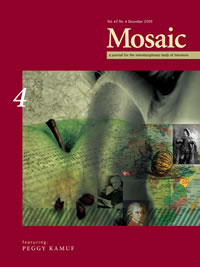Issue 42.4
Overview

Feature Author Issue: Peggy Kamuf
Published: December 2009
View the issue introduction or see the issue summary and contents below.
11 essays, totalling 192 pages
$19.95 CAD
Featuring a Mosaic “Crossings” series interview with, and two essays by, Peggy Kamuf, this is a fascinating issue that engages opera, criticism, poetry, fiction, fairy tale and film, and that includes essays on the work of Hélène Cixous, Jean-Luc Nancy, Emil Cioran, Eamon Grennan, Jean-Luc Nancy and Benedict Anderson.
Crossings: An Interview with Peggy KamufDawne McCance The following interview took place in Winnipeg on 2 October 2008. Mosaic is pleased and honoured to publish the interview here. | |
Outside in AnalysisPeggy Kamuf The essay addresses the complex relations that works of Derrida and Hélène Cixous maintain with psychoanalysis. Arguing that both of them take on the psychoanalytic legacy, it advances the notion that both Derrida and Cixous pose to psychoanalysis the question of compassion. | |
The Deconstitution of PsychoanalysisPeggy Kamuf Through a brief reading of four interventions by Derrida, this essay traces how they put psychoanalysis as institution under deconstructive pressure. The leverage comes from the situation of a stranger`s address to the institution that nevertheless occupies the place of a question opening up from within, having been solicited there as a supplement from the outside. | |
“Something Secret and Still”: Silence in the Poetry of Eamon GrennanTimothy Baker Previous criticism of the Irish-American poet Eamon Grennan has focused on his depictions of the natural world. Through a comparison with the French poet Yves Bonnefoy, this essay explores Grennan’s concern with the failure of language and highlights the way his poetry reveals the world through notions of silence and absence. | |
Le mal sonore dans l’écriture de Cioran, ou l’écriture a l’écoute des demonsSARA DANIÈLE BÉLANGER MICHAUD Cet essai développe autour de la probématique de la voix et de la polyphonie telle quèelle se présente dans l’écritue de Cioran. La question de la voix y est associée à celle de « damôn » et toures deux prennent leur ancrage chez Cioran dans un « mal ontologique » qu’on rapproche du « désepoir démoniaque » kierkegaardien. | |
The Provocation of Hélène Cixous: Philosophy in Poetic OverflowAnthea Buys and Stefan Polatinsky Through an exploration of Cixous’s treatment of the textual motifs of the “unwritten book” and the enigma of the apple, this article considers the ways in which Cixous’s writing suggests an alternative forum for considering issues that preoccupy occidental philosophy. | |
Community and Literary Experience in (Between) Benedict Anderson and Jean-Luc NancyPieter Vermeulen A comparison of the notions of the imagined community (Benedict Anderson) and the inoperative community (Jean-Luc Nancy) reveals how Anderson’s and Nancy’s very different projects both invest literature with the capacity to ground a form of community that differs from the national community (founded in the anonymity of the cenotaph) and the operative community (founded on myth). | |
Magic Realities Reconsidered: Ever AfterDorothee Ostmeier By contextualizing the film Ever After in terms of its revisions of the classic versions of the Cinderella story and of Renaissance ideas of social reform, this study presents the contemporary Cinderella as an imaginary construct of several layers of cultural history and of literary and artistic subplots. | |
Don Giovanni and the Storytelling of Isak Dinesen: Mosaic Art and the Articulation of DesireRonald Schleifer Focusing on Don Giovanni and the stories of Isak Dinesen, particularly on “Babette’s Feast” and “The Dreamer,” in which the protagonists sing Mozart’s opera, this essay examines the function of mosaic aesthetics in narrative and music in the terms of Charles Sanders Peirce, particularly “iconic” sensuousness. | |
Between Noise and Language: The Sound Installations and Music of Peter AblingerG. Douglas Barrett Throughout his career, Peter Ablinger has focused extensively on noise in nearly every capacity, especially as it appears in his ongoing Weiss/Weisslich (White/Whitish) series. This essay discusses some of these works along with a specific piece from Ablinger’s phonorealism series, in which recorded speech is transformed directly into the music-mechanical production of tones played by a computer-controlled player piano. | |
The Erasure of Grace: Reconnecting Peyton Place to its AuthorAnna G. Creadick This essay reconnects the 1956 blockbuster Peyton Place to its largely forgotten author, Grace Metalious. Reading the novel alongside its early publicity shows how Metalious’s public persona powerfully shaped her text’s original reception. Both author and text launched a lasting critique of mid-century America’s “bourgeois pretensions.” |